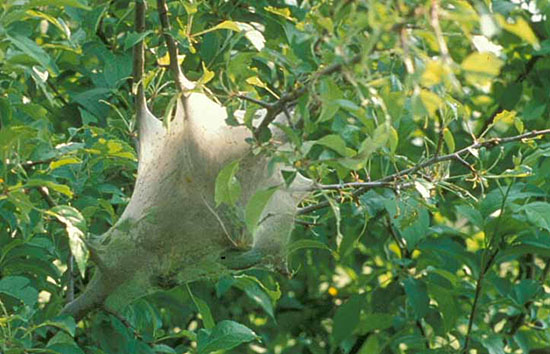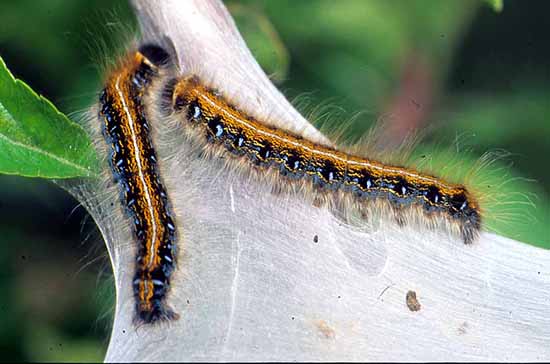Issue 2, May 4, 2015
Eastern Tent Caterpillar
Eastern tent caterpillar has hatched throughout Illinois. They are particularly numerous in southern Illinois, particularly along I-70. Removal of the tents at night or on cloudy days, or the application of an insecticide such as Bacillus thuringiensis kurstaki (Dipel, Thuricide), is recommended at this time to prevent heavy defoliation.
The larvae hatch at bud break of their hosts, which are primarily trees in the rose family. These include crabapple, wild black cherry, hawthorn, serviceberry, mountain ash, flowering plum, and flowering cherry. Fruit trees, including apple, peach, apricot, pear, and plum are also attacked. When newly hatched, the larvae are black but develop yellowish white stripes down their back within a few days. After sitting on the egg mass on the twig for a couple of days, the larvae migrate to a twig crotch where they spin a white, communal silk tent.

Eastern tent caterpillar tent.
The caterpillars leave the silk tent at various times throughout the day to feed on the leaves. Leaves are eaten from the margin inward, sometimes leaving only the midvein, which soon dries, curls, and falls off of the tree. Heavily infested trees can be totally defoliated. Defoliated trees typically survive this feeding damage and releaf later in the spring with few, if any, noticeable effects.
Fully grown larvae reach about 2 inches in length and are black, with an obvious yellowish white stripe down the back. Close examination reveals gold stripes, blue spots, and other small markings. As the caterpillars become larger, they increase the size of their tent to accommodate them.

Eastern tent caterpillar larvae on tent.
When fully grown, the larvae leave the tree and migrate across the ground until they find a protected area to pupate within a silk cocoon. Adult moths emerge in about 2 weeks and are brown, with white bands across the wings. They are about 1 inch long with 1-1/2-inch wingspans. After mating, female moths lay their eggs in reddish brown clusters that wrap around pencil-size-diameter branches. Each egg mass is about 1/2 inch long and contains 100 to 300 eggs. These eggs do not hatch until the following spring when bud break occurs. (Phil Nixon)
Author:
Phil Nixon